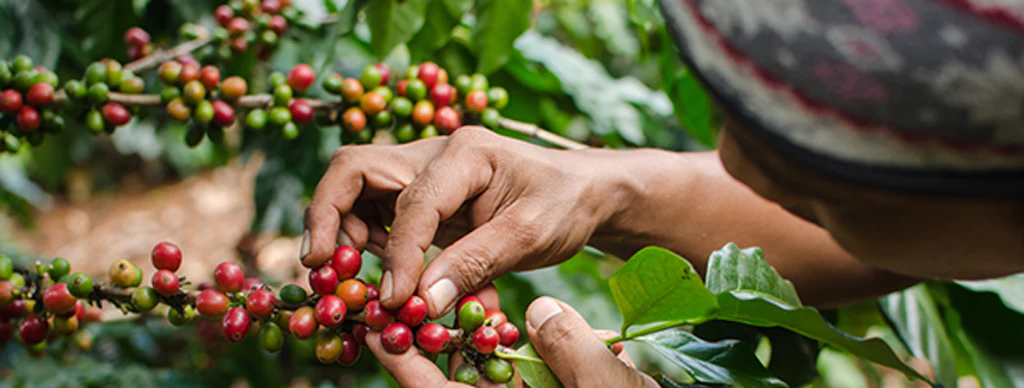
Courtesy of Chartsbin.
Coffee the second most traded commodity in the world after oil- can be found- in the most diverse varieties in Asia. Generally- known for its cheap coffee and instant products, Asia also features many remarkable coffees.
Nowadays, many coffee drinkers are favourable towards organic coffees. Interestingly, coffees in Asia are grown organically by default because many farmers are not capable of affording the fertilizers and chemicals required for commercial coffee production.
Let’s take a look at some of the coffee-growing Asian countries.

Vietnam
Vietnam is the second-largest global coffee producer, after Brazil. Despite being young in the coffee culture, Vietnam is renowned as the epicenter of Robusta production. Producing 1,830,000 metric tons (4,034,000,000 pounds), Vietnam now accounts for 17% of the world’ coffee.
Coffee production in Asia developed in the 1990s via heavy inoculation of cash from the World Bank, which saw money to be made by exporting beans. Sadly, despite the volume produced, Vietnam specializes in low-grade Robusta coffee, a bitter bean often used in blends to “cut” the amount of high-grade Arabica needed.
Robusta makes up approximately 95% of Vietnamese coffee, with Arabica making up the remaining 5%.
The traditional style of making Vietnamese coffee is known all around the world. Vietnamese people brew it strong and mix it with thick condensed milk and sugar. Coffee in Vietnam is served in a little plastic bag with a straw because plastic or paper cups aren’t affordable.
India
India is next as another major coffee-producing country in Asia. It was the first major region outside of- Arabia and Africa to cultivate coffee, primarily due to some clever smuggling of fertile coffee beans.
India has a vast variety of climate conditions and a huge landmass. With its growing popularity, India produces coffee beans of mentionable quality. Today, even the American brand, Starbucks is offering Indian beans and giving its black gold a go.
India’s best-known varietal, the so-called monsoon coffee- is even famous in Europe.
India produces 329,100 metric tons (726,000,000 pounds) of coffee. It accounts for 3% of the global output.
Indonesia
Indonesia, a far stretched archipelago consisting of thousands of tropical islands, is challenging to navigate. It produces both Arabica and Robusta.,/span>
Although, Indonesia is still the fourth most coffee-producing nation worldwide, a lot of the Robusta that it produces is of medium to low quality. The less favourable Robusta is- mostly processed- into instant coffee or other cheap coffee products, and only a portion- approximately 10% of Arabica- is produced.
Indonesia does have some high-quality varietals too. Globally famous is the full-bodied, Mandheling Arabica from Sumatra as well as- the Kopi Luvac coffee that is eaten and dropped out by Indonesian wild cats.
Indonesia produces 642,000 metric tons (1,415,000,000 pounds) of coffee. Indonesia now accounts for 6% of the world’s coffee.
China
Primarily known for tea just like India, China on the coffee-producing nation list is somewhat- of a surprise. Two decades ago, the Americanization of China begun and is still progressing.
Statistically, on average, a Chinese person only drinks about three cups of coffee annually. But with the heavy popularization of coffee in the western world, the demand for coffee is seemingly growing among the Chinese middle class and people who can afford coffee.
China produces both Robusta and Arabica. With 138,000 metric tons (304,000,000 pounds) of Arabica coffee, China accounts for 1.3% of the world’s Arabica and is a constant growing influence in the world of coffee-producing nations.
Thailand
Comparatively still very young to other international coffee producers, various methods of processing coffee are credited to Thailand, such as honey processing by local farmers.
In the 1970s, King Bhumibol Adulyadej launched a series of coffee projects in the north to help local communities grow cash crops such as coffee, as an alternative to growing opium poppies.
Thailand has been growing coffee for a little over a century. But didn’t become an exporter until 1976 when the nation started exporting Robusta beans. The production has since broadened, and Arabica has become more common and popular among coffee drinkers, so now more Arabica comes from Thailand than Robusta.
The Arabica plant thrives in- areas of heavy rainfall and higher elevations, so the hill tribes of Thailand are perfect to produce it. Arabica coffee beans are commonly grown in the Chiang Mai province in northern Thailand. The other type of coffee bean, Robusta- is grown mostly in the southern parts of Thailand.
Direct trade and fair trade gained popularity- as a way to support local farmers rather than greedy corporations not paying farmers fair prices.
Producing 42,000 metric tons (93,000,000 pounds) of coffee means Thailand supplies the planet with about 0.4% of its coffee.